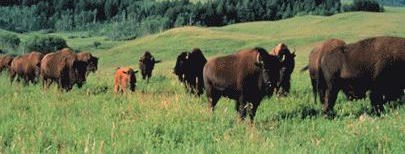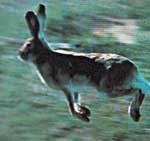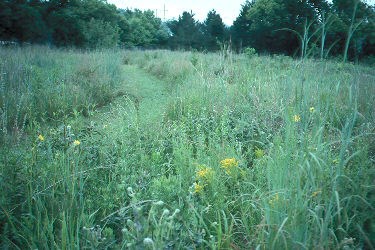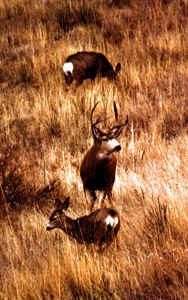
Hunting was especially popular among the officers of the frontier army, many of whom hunted from horseback. Speed was the order of the day, especially when it came to this diversion, hunting. Horses were handy for seeking out game. They also could be used when chasing such large prey as bison. Numerous accounts from the Central Plains and as far south as New Mexico indicated the popularity of buffalo hunts from the 1840s through the decades after the Civil War. 
Sometimes, smaller game would be sought in a western version of the English gentry's passion, the hunt. Rather than trail a fine fox , the group settled for a lowly coyote or even a jack rabbit. They also replaced the, "Big-eared foxhounds of the East with sleek greyhounds on many occasions. In 1850, Captain Thomas Rhett hunted with these fast dogs while George Custer's pack included fox and stag hounds. Stephen Watts Kearney, George McCall, and numerous other officers shared this affinity for hunting dogs as well as other smaller creatures which came to be family pets. Whether galloping after a buffalo from horseback or stalking elk, deer, prairie hen, duck, grouse, wild turkey, possum or any other wildlife found on the frontier, many hours could be passed in hunting. Fishing proved popular, too, in those locations where water permitted. In 1857, an officer on the Utah expedition found that all he needed was a grasshopper for bait. Within a half hour he had landed six fish, each weighing a half pound, Decades later, Captain Biddle periodically provided a breakfast of trout for his family which he brought back to his quarters for preparation. Conversely, Alice Baldwin recalled that even though there was no butter available, bacon grease in a skillet over an open fire was ample to prepare the fish caught at Agua Azula Springs. As a matter of fact, her observation underscored one side benefit of hunting and fishing. In addition to providing exercise as well as honing skills with weapons and on horseback, the meager fare available from the Quartermaster could be supplemented with a more varied source of foodstuff. For instance, Maria Kimball noted that after successful hunts, the menu included antelope chops for breakfast, Missouri River catfish along with prairie chicken and roast buffalo for lunch and a supper of elk steak at night. While appetizing as a change of pace, the constant dependence on game as a source of meat made one officer's lady lament the absence of fresh beef from the diet. The preceding information was taken from Soldiers at Play. The following information is an article written by a former park ranger at Fort Scott NHS (used by permission). "'Everybody Here is Hunting Mad,' Hunting at Fort Scott in the 1840s" On crisp autumn mornings when I had a day off from my park ranger job at Fort Scott NHS, I would drive in the pre-dawn darkness to my favorite duck pond south of town. While peering through the Indian grass that surrounded my blind, I waited for legal shooting time and wondered: what was hunting like for the military officers at Fort Scott 150 years ago? What sweeping vistas greeted them as they rode out to their favorite hunting spots? In the years before Kansas became a state, the scenery and the plentiful game must have been spectacular! Second Lieutenant David A. Russell, stationed at Fort Scott in December 1845, summed it up in a letter to his brother in Ohio, "The opportunities for fishing and hunting cannot be surpassed at any other post in the army . . ." Established in 1842, Fort Scott was situated in the midst of rolling tallgrass prairie on a limestone bluff overlooking the heavily timbered Marmaton River. Just a half dozen miles from the Missouri line, it was indeed the place "where the sky began." Easterners were struck by the immenseness of the open land. Lieutenant Russell's initial reaction to Fort Scott was not favorable, he complained, "It is the most lonely, dreary, and manforsaken place you ever saw." 
Fort Scott was ideally suited to be surrounded by an endless variety of wildlife. The fort was built in a biological "edge" area with thousands of acres of virgin prairies, natural lakes, and densely wooded streams nearby. The prairie grasses burned often, choking any small trees trying to sprout. Moisture and dense vegetation near waterways provided an impenetrable barrier against the raging fires. Captain George A. McCall described the Garden of Eden-like variety of wildlife to be found in the vicinity of Fort Scott. In season, "we have the deer, turkey, grouse, partridge, woodcock, snipe, plover, of half a dozen or more species; and on the lakes near the river, swans, geese, of two or tree species; and ducks without number; pelicans, sand-hill cranes, &c. Altogether, including its fine climate, it is a glorious country for the sportsman." The garrison at Fort Scott usually consisted of eight officers and 150 enlisted men. Most officers came from well-to-do families and were educated at the US Military Academy at West Point, while the men they commanded were often illiterate. Soldiers under the rank of lieutenant were not of the proper social station and did not enjoy the opportunities for pleasure hunting like their commanders. During their non-duty hours, the officers donned buckskin hunting outfits and blasted at migrating ducks by the thousand with black powder guns or searched for coyotes and deer with packs of dogs. The lone authorized civilian on post, the sutler Hiero T. Wilson, provided hunting supplies the officers could not receive or buy from the government. In September 1844, Fort Scott officers purchased from Wilson such items as a box of percussion caps for 12 1/2 cents, 3 pounds of shot for 25 cents, a powder flask for $1.50, and a pound of black powder for 50 cents. Captain Thomas Swords, designer and stern post-quartermaster of Fort Scott, wrote numerous letters to fellow dragoon officer Abraham Johnston, who was stationed elsewhere on the frontier. Swords frequently inserted references to hunting in his correspondence. In a December 1842 letter he remarked that Captain William Eustis (stationed a few miles away at the post's saw mill) had plenty of "horses, guns, pointers and hounds, but never hunts . . . I go out generally when the others do, that is once or twice a week if the weather permits, --sometimes have fine sport--have a very fine country to run over and not the same chance as at L. (Fort Leavenworth) for a body to get his neck broken." 
The home of "Colonel" George Douglas, about ten miles into Missouri, was a favorite hunting destination. Mr. Douglas was an early settler of Vernon County, Missouri who helped the military select the site of Fort Scott. In March 1843 Post Commander Benjamin Moore took advantage of the spring waterfowl migration, and spent at least four days duck shooting with Douglas. Captain Swords noted the arrival to the fort of a pack mule loaded down with ducks. In December 1844, in a letter to Johnston, Swords asserted, "everybody here is hunting mad. Hunting and dogs constitute their thoughts by day and dreams by night--Have caught two bucks, with the greyhounds, so that wolf chasing is thrown quite in the shade--there are many deer about and at least two hunters for every deer--the Delawares and Pottawattamies camped in every direction--I go out occasionally but being very unsuccessful as usual (do) not make a business of it." Captain Swords noted that Native Americans competed with Fort Scott's hunters for deer. The Delaware, Potawatomie, and other tribes were relocated from the East to present-day Kansas to join the native Kansa and Osage Indians. The mission of Fort Scott's garrison was to keep peace along the "permanent Indian frontier," west of Missouri and Arkansas. Several officers viewed hunting as a welcome diversion to the isolation, monotony, and rigors of military life on the frontier. Swords said of Captain Burdett Terrett, "duck-shooting and wolf chasing are the only things that at all reconcile him to the place." Captain Swords' wife, Charlotte, was a vivacious busybody, conscious of her proper role in society. Her keen sense of humor helped her cope with life at the edge of civilization. In a letter to Captain Johnston she declared, "I hunt with my husband and in the hall stands my bow and arrow ready strung for the first unfortunate Buffalo that makes his appearance at Scott." She would have waited a long time, since bison ranged at least two hundred miles west of the fort! Captain McCall, who was stationed at Fort Scott from 1843 to 1845, wrote at great length about his hunting trips in his book Letters From the Frontiers. Vivid descriptions of hunting escapades with his dogs and "negro boy Jordan" near Fort Scott were included in McCall's letters. (In the antebellum army, many officers--even New Yorkers like Thomas Swords--were slaveholders.) McCall's favorite hunting dog was a setter and pointer cross named, of all things, Blue. According to McCall, Blue was bred from imported stock and had a massive chest. Although Blue had a wonderful nose for grouse, woodcock, or turkey, McCall bragged, "it was a deer-dog he was destined to shine without a rival." 
In early November 1844, George McCall claimed to have killed a deer without firing a shot. Blue surprised a bedded down buck, eventually catching hold of a rear leg when the deer stumbled in the tall "horseweeds," (probably Big Bluestem grass which can grow to heights of nine or ten feet). With his hunting knife, McCall slit the buck's throat, but failed to kill the strong animal as the deer leaped away with Blue in hot pursuit. Blue and then McCall caught up with the buck twenty-five yards away as it failed to cross a gully. Jordan and the Captain packed the animal back to the fort with a story to tell! Hunting was a part of life on the frontier. Hunting not only provided spirited adventure and recreation, it put food on the table. Wild turkey or veal, along with vegetables from the post gardens, were certainly welcome additions to the dining room table. With modern conservation and the use of regulations, licensing, and habitat preservation, we all can enjoy a day afield as much as Captain McCall or Lieutenant Russell did a century and a half ago. Westward movement, the Mexican War, the Civil War, railroads, homesteading, farming and industrial development shattered the world they knew. Today we are likely to see barbed wire and tractors rather than the panoramic scenes Captain McCall described. However, we can enjoy reading his descriptions and, I think, we can relate to his sentiments after a hard day in the field. McCall wrote, "on reaching my quarters, I found a turkey just ready to be dished; and by the time dinner was on the table, I had made my ablutions, dressed, and was ready to sit down to it, with a hunter's appetite, which is next in degree, and only inferior to that of a soldier's after a hard day's march."
|
Last updated: July 30, 2016

